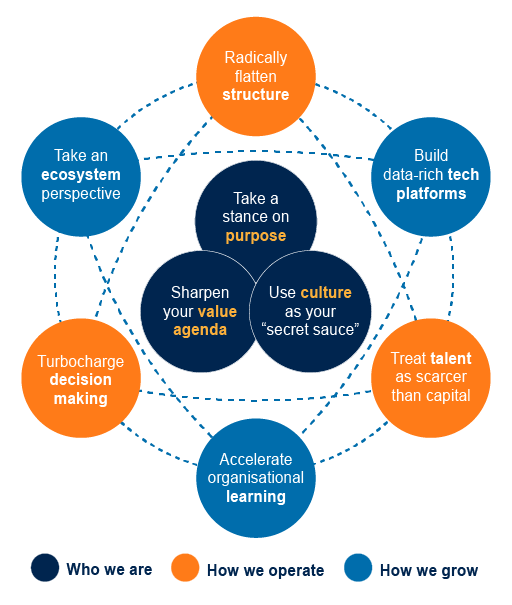1.4 Future trends of work
Many higher education institutions (HEIs) are reflecting on lessons learned from reactive ways of working during the pandemic and evolving their working practices and policies to embed more inclusive and proactive ways of working. In higher education (HE) this has resulted in more hybrid work environments and developing their capabilities in response to digital transformation. While there is more for organisations to navigate and implement, many can now take a more reflective approach. They can take the time to plan for what is needed in both the short- and long-term and continue to embed more sustainable ways of working.
As organisations plan for the future, the wellbeing and expectations of employees and the employee experience, need to be priorities. As teams are more distributed, traditional unit functions may no longer be appropriate for these new ways of working, so organisational structures need to be developed in line with these changes.
The Gartner article ‘9 Future of work trends post covid-19’ [Tip: hold Ctrl and click a link to open it in a new tab. (Hide tip)] (Turner and Baker, 2022) identify trends that have the greatest impact on the employee experience as:
- Hybrid work becomes mainstream
- There’s a shortage of critical talent
- Well-being is a key metric
- DEI (diversity, equity and inclusion) outcomes could worsen
- Turnover will increase
- Managers’ roles are changing
- Gen Z wants in-person work experiences
- Shorter work weeks are a new EVP (employee value proposition)
- Data collection is expanding
You may recognise some of these trends in your organisation today, others you may feel are on the horizon. When it comes to identifying the need to plan for hybrid working, Turner and Baker, (2022) suggest you are not alone – their article states nearly 39% of organisations would risk losing employees if they went back to fully on-site arrangements. While according to the Office for National Statistics (2022), of all employees surveyed, 84% of workers that worked from home during the pandemic intend to carry out a mix of working at home and in their place of work in the future.
Of course, there is a difference between having to work remotely during a period of global crisis, where individuals and organisations had to be quick to adapt to working and learning from home, and developing a long-term strategy to support workers, customers and other stakeholders who choose to work remotely at least some of the time.
This means, as an organisation, your awareness and understanding of employees’ expectations is critical to managing expectations and also for effective planning and strategy development. We frequently hear ‘one size does not fit all’ but for an organisation the reality is, you have to find a balance in order to operate effectively. This may require radical transformation. The McKinsey and Company article ‘Organizing for the future: Nine keys to becoming a future-ready company’ (De Smet et al., 2021) states reinvention is needed, and proposes the following nine imperatives that future-ready companies will exhibit.
The trends and imperatives may be areas you already consider, however, delivering such a strategy requires embarking on a journey from understanding why you want to do it, through consideration of the challenge from every angle (organisationally, personally, and societally) to careful planning and change management – all within a context of continual uncertainty.
Activity 4 What will these trends and imperatives mean to your organisation?
Refer back to the Gartner article ‘9 Future of Work Trends Post Covid-19’ (Tuner and Baker, 2022) and the McKinsey article ‘Organizing for the future: Nine keys to becoming a future-ready company’ (De Smet et al., 2021).
Consider the trends that may impact the employee experience, then the think about organisational imperatives that are required to be a future-ready organisation.
How future ready do you think your organisation is, and what might your need to focus on?

